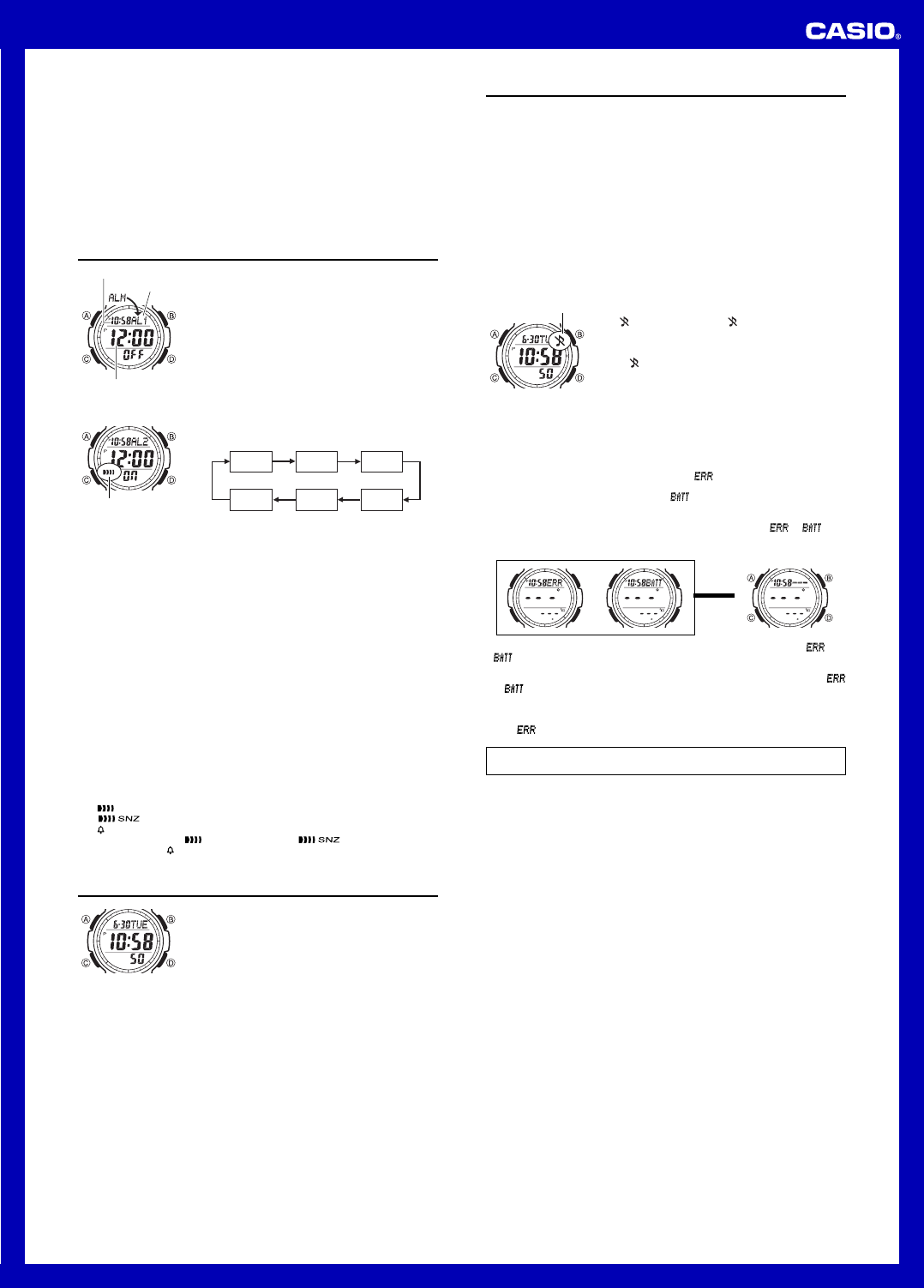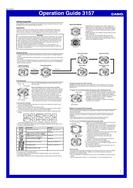
Operation Guide 3157
4
To use the countdown timer
Press D while in the Countdown Timer Mode to start the countdown timer.
• When the end of the countdown is reached and auto-repeat is turned off, the alarm
sounds for 10 seconds or until you stop it by pressing any button. The countdown
time is automatically reset to its starting value after the alarm stops.
• When auto-repeat is turned on, the countdown will restart automatically without
pausing when it reaches zero. The alarm sounds to signal when the countdown
reaches zero.
• The countdown timer measurement operation continues even if you exit the
Countdown Timer Mode.
• To stop a countdown operation completely, first pause it (by pressing D), and then
press A. This returns the countdown time to its starting value.
Alarms
The Alarm Mode gives you a choice of four one-time
alarms and one snooze alarm.
Also use the Alarm Mode to turn the hourly time signal
(
SIG) on and off.
• There are five alarms numbered
AL1through AL4,
and
SNZ. You can configure SNZ as a snooze alarm
only. Alarms
AL1through AL4 can be used as one-
time alarms only.
• When you enter the Alarm Mode, the data you were
viewing when you last exited the mode appears first.
• All of the operations in this section are performed in the
Alarm Mode, which you enter by pressing C.
Alarm time
(Hour : Minutes)
Alarm number
Current time
To set an alarm time
1.In the Alarm Mode, use D to scroll through the alarm
screens until the one whose time you want to set is
displayed.
AL1 AL2 AL3
SNZSIG AL4
2. Hold down A until the hour setting of the alarm time start to flash, which indicates
the setting screen.
• This automatically turns on the alarm.
3. Press C to move the flashing between the hour and minute settings.
4. While a setting is flashing, use D (+) and B (–) to change it.
• When setting the alarm time using the 12-hour format, take care to set the time
correctly as a.m. (no indicator) or p.m. (P indicator).
5. Press A to exit the setting screen.
D
Alarm on indicator
Alarm Operation
The alarm tone sounds at the preset time for 10 seconds, regardless of the mode the
watch is in. In the case of the snooze alarm, the alarm operation is performed a total
of seven times, every five minutes, until you turn the alarm off.
• Alarm and hourly time signal operations are performed in accordance with the
Timekeeping Mode time.
• To stop the alarm tone after it starts to sound, press any button.
• Performing any one of the following operations during a 5-minute interval between
snooze alarms cancels the current snooze alarm operation.
Displaying the Timekeeping Mode setting screen
Displaying the
SNZ
setting screen
To test the alarm
In the Alarm Mode, hold down D to sound the alarm.
To turn an alarm and the hourly time signal on and off
1. In the Alarm Mode, use D to select an alarm or the hourly time signal.
2. When the alarm or the hourly time signal you want is selected, press A to toggle it
on and off.
: Indicates alarm is on.
: Indicates snooze alarm is on.
: Indicates Hourly Time Signal is on.
• The alarm on indicator (
), snooze on indicator ( ), and hourly time
signal on indicator (
) are displayed on all modes.
• If any alarm is on, the alarm on indicator is shown on the display in all modes.
Illumination
This watch has an EL (electro-luminescent) panel that
causes the entire display to glow for easy reading in the
dark.
• The electro-luminescent panel that provides illumination
loses power after very long use.
• Illumination may be hard to see when viewed under
direct sunlight.
• The watch may emit an audible sound whenever the
display is illuminated. This is due to vibration of the EL
panel used for illumination, and does not indicate
malfunction.
• Illumination turns off automatically whenever an alarm
sounds.
• Frequent use of illumination runs down the battery.
To turn on illumination
In any mode (except when a setting screen is on the display), press B to illuminate
the display for about one second.
Reference
This section contains more detailed and technical information about watch operation.
It also contains important precautions and notes about the various features and
functions of this watch.
Auto Return Feature
• The watch will return to the Timekeeping Mode automatically if you do not perform
any operation for about two or three minutes while in the Digital Compass/
Thermometer Mode or Alarm Mode.
• If you leave a screen with flashing digits on the display without performing any
operation for two or three minutes, the watch saves any settings you have made up
to that point and exits the setting screen automatically.
Button Operation Tone
The button operation tone sounds any time you press one of the watch’s buttons. You
can turn the button operation tone on or off as desired.
• Even if you turn off the button operation tone, the alarm, hourly time signal, and
Countdown Timer Mode alarm all operate normally.
To turn the button operation tone on and off
In any mode (except when a setting screen is on the
display), hold down C to toggle the button operation tone
on (
not displayed) and off ( displayed).
• Since the C button also is the mode change button,
holding it down to turn the button operation on or off also
causes the watch’s current mode to change.
• The
indicator is displayed in all modes when the
button operation tone is turned off.
Data and Setting Scrolling
The B and D buttons are used in various modes and setting screens to scroll
through data on the display. In most cases, holding down these buttons during a scroll
operation scrolls through the data at high speed.
Mute indicator
Sensor Error and Low Battery Displays
Subjecting the watch to strong impact can damage the sensor or cause internal
connection problems. These conditions will cause
(error) to appear on the
display, indicating that sensor operation is disabled.
Sensor operation also is disabled whenever
(battery) is on the display, which
indicates insufficient battery power or voltage due to a low battery or a cold
environment.
• If an error occurs or the battery goes low during sensor operation,
or will
appear in the upper right of the display for about 10 seconds, and then change to
---.
▲
• If an error occurs or the battery goes low during bearing sensor correction, or
will appear in the upper right of the display for about one second, and then the
calibration screen will appear. Try performing calibration again.
• If an error occurs or the battery goes low during temperature sensor calibration,
or will appear on the display for about one second. Next, xxx will flash for the
temperature value in the center of the display.
This indicates that temperature sensor calibration is not possible. Press A to exit
the calibration screen, and then try performing temperature sensor calibration again.
• If the
message appears frequently, it could mean the sensor is malfunctioning.
Whenever you have a sensor malfunction, be sure to take the watch to your original
dealer or nearest authorized CASIO distributor as soon as possible.
Timekeeping
• Resetting the seconds to 00 while the current count is in the range of 30 to 59
causes the minutes to be increased by 1. In the range of 00 to 29, the seconds are
reset to 00 without changing the minutes.
• With the 12-hour format, the P (PM) indicator appears on the display for times in the
range of noon to 11:59 p.m. and no indicator appears for times in the range of
midnight to 11:59 a.m.
• With the 24-hour format, times are displayed in the range of 0:00 to 23:59, without
any indicator.
• The year can be set in the range of 2000 to 2099.
• The watch’s built-in full automatic calendar makes allowances for different month
lengths and leap years. Once you set the date, there should be no reason to change
it except after you have the watch’s battery replaced.
• The times for the Timekeeping Mode and all the city codes of the World Time Mode
are calculated in accordance with each city’s UTC offset.
• The UTC offset is a value that indicates the time difference between a reference
point in Greenwich, England and the time zone where a city is located.
• The letters UTC is the abbreviation for Coordinated Universal Time, which is the
world-wide scientific standard of timekeeping. It is based upon carefully maintained
atomic (cesium) clocks that keep time accurately to within microseconds. Leap
seconds are added or subtracted as necessary to keep UTC in sync with the Earth’s
rotation.





















